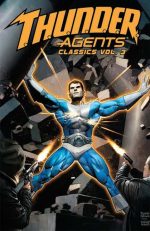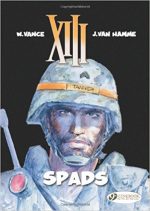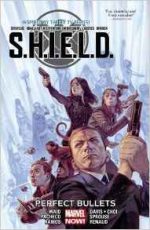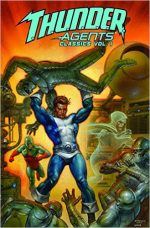
By Ian Fleming, Jim Lawrence & Yaroslav Horak (Titan Books)
ISBN: 987-1-78565-325-4
Win’s Christmas Gift Recommendation: A Truly Traditional Licence to Thrill… 9/10
There are sadly few British newspaper strips that can rival the influence and impact of the classic daily and Sunday “funnies†from America, especially in the field of adventure fiction. The 1930’s and 1940’s were particularly rich in popular, not to say iconic, creations and you’d be hard-pressed to come up with household names to rival Popeye, Dick Tracy or Flash Gordon, let alone Blondie, Little Orphan Annie or Popeye – and yes, I know I said him twice, but Elzie Segar’s Thimble Theatre was funny as well as thrilling, constantly innovative, and really, really good. You should really read them if you haven’t yet…
What can you recall for simple popularity let alone longevity or quality in Britain? Rupert Bear? Absolutely. Giles? Technically, yes. Nipper? Jane? Garth? I’d hope so, but I doubt it. The Empire didn’t quite get it until it wasn’t an empire any more. There were certainly many wonderful strips being produced: well-written and beautifully drawn, but that stubborn British reserve just didn’t seem to be in the business of creating household names.
Until the 1950’s…
Something happened in the Britain of the New Elizabethans – and I’m not going to waste any space here discussing it. It just did. Now we’re moving on.
In a new spirit that seemed to crave excitement and accept the previously disregarded, comics got carried along on the wave. Eagle, Lion, the regenerated Beano and girls’ comics in general all shifted into visually receptive high gear… and so did daily newspapers at a time when print was everyone’s major source of staying in touch with the world…
Thanks to another canny and comforting luxury repackaging – just in time for the Christmas presents rush! – I can once more communally reminisce about one of British strip-cartooning’s greatest triumphs, since Titan Books have a new addition to their line of lavish, oversized (294 x 277 mm) monochrome compilations of Ian Fleming’s immortal James Bond.
Debut 007 novel Casino Royale was published in 1953 and subsequently serialised in the Daily Express from 1958: initiating a sequence of paperback novel adaptations scripted by Anthony Hern, Henry Gammidge, Peter O’Donnell and Kingsley Amis before Jim Lawrence (a jobbing writer for American features who had previously scripted the aforementioned Buck Rogers) signed on for The Man with the Golden Gun to complete the transfer of the authorial canon to strip format.
When that mission was accomplished, Lawrence was invited to create new adventures, which he did until the strip’s ultimate demise in 1983.
Illustration of the feature was always of the highest standard. Initially John McLusky provided art the until 1966’s conclusion of You Only Live Twice and – although perhaps lacking in vivacity – the workmanlike clarity of his drawing easily coped with the astonishing variety of locales, technical set-ups and sheer immensity of cast members…
He was succeeded by Yaroslav Horak, who also debuted on Golden Gun; instituting a looser, edgier style, at once more cinematic and with a closer attention to camera angle and frenzied action that seemed to typify the high-octane vim and verve of the 1960’s. Horak illustrated 26 complete adventures until 1977 when The Daily Express ceased carrying Bond and the then-running case suddenly switched to The Sunday Express (from January 30th until conclusion on May 22nd).
Here, however, the heady brew of adventure, sex, intrigue and death is at an all-time high in this addictively accessible fourth volume which finds the creators on top form as they reveal how the world’s greatest agent never rests in his mission to keep us all free, safe and highly entertained…
The frantic derring-do and dark, deadly last-ditch double-dealings commence once superstar screenplay writers Neal Purvis & Robert Wade (The World is Not Enough; Die Another Day; Casino Royale; Quantum of Solace; Skyfall and Spectre as well as Johnny English) share some secrets and observations in their Introduction ‘Adapting Bond’.
Then ‘Octopussy’ (Daily Express 14th November 1966 – 27th May 1967) unfolds: a classic Ian Fleming tale. Originally a short story, under the skilful hands of Lawrence & Horak, a simple smuggling caper in the West Indies blossoms into a complex tale of Nazi Gold, murdered agents and exotic deaths in exotic locales as Bond pits his wits against deplorable rogue Major Smythe….
Bowing to the wave of popularity caused by the blockbuster films of the time, there are even a few Q Branch gadgets on offer. Horak excels at the extended underwater sequences and the action is frenetic and non-stop. Moreover, thanks to the enlarged landscape pages of this edition, every picturesque detail is there to be drooled over…
The sea also plays a major role in ‘The Hildebrand Rarity’ (29th May – 16th December 1967) which details the true fate of a new Royal Navy robot weapon which seemingly fails but has in fact been stolen by flamboyant millionaire and career sadist Milton Krest. At his most dashing undercover best, Bond infiltrates the wealthy sicko’s glamorous circle in a terrific tale full of innovation and intrigue. You won’t believe how many ways there are to kill with fish!
Having exhausted Fleming’s accumulated prose canon, all-original material begins with ‘The Harpies’ (4th October 1968 – 23rd June 1969) as Bond adopts he persona of ex-copper Mark Hazard to infiltrate defence contractor Simon Nero‘s factory and rescue a kidnapped scientist whilst seeking to end the depredations of a deadly gang of female flying bandits.
Here Horak’s extreme design style and dynamic lines impart tremendous energy to scenes that must labour under the incredibly difficult restrictions of the 3-panel-a-day newspaper format.
Wrapping up the sinister espionage shenanigans is Lawrence’s second addition to 007 lore – and what a cracker it is! In ‘River of Death’ (24th June – 29th November 1969) Bond must penetrate the Amazon River stronghold of a maniacal oriental scientist and former Red Chinese torturer Dr. Cat. This latest madman is supplying trained animals to international criminals for the purposes of robbery, espionage and murder…
Horak’s intense illustration is approaching a career peak here and easily copes with action, mood, cutting edge science, beautiful women and exotic locales as diverse as the Alps, sultry Rain Forests, London’s underworld and Rio de Janeiro at Carnival time.
James Bond is the ultimate secret agent. You all know that and have – thanks to the multi-media empire that has grown up around Ian Fleming’s masterful creation – your own vision of what he looks like and what he does. That’s what dictates how you respond to the latest movie, game or novel. Here, however, is James Bond at his suave and savage best and as close to his original conception and roots as you will ever find.
Fast, furious action, masses of moody menace, sharply clever dialogue and a wealth of exotic locales and ladies make this an unmissable adjunct to the Bond mythos and a collection no fan can do without. After all, nobody does it better…
Octopussy © Ian Fleming Publications Ltd/Express Newspapers Ltd 1966. The Hildebrand Rarity © Ian Fleming Publications Ltd/Express Newspapers Ltd 1967. The Harpies © Ian Fleming Publications Ltd/Express Newspapers Ltd 1969. River of Death © Ian Fleming Publications Ltd/Express Newspapers Ltd. 1969. James Bond and 007 are ™ of Danjaq LLC used under licence by Ian Fleming Publications Ltd. All Rights Reserved.
The Complete James Bond: OCTOPUSSY – the Classic Comic Strip Collection 1966-1969 will be published on November 24th and is available for pre-order now.









